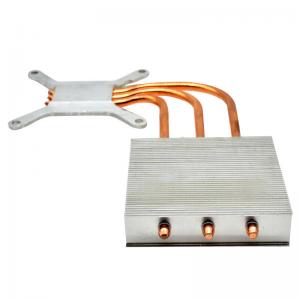

Add to Cart
Aluminum Fin Heat Pipe Radiator With 3 Pcs Heat Pipes For CPU Cooler
Quick Detail
| Raw Material | AL5052 and 4 heat pipe |
| Custom Service | Yes, OEM/ODM Service |
| Quality System | ISO9001:2015 |
| Processing Technology | Cutting/Wood machining/CNC/Riveting |
| Surface treatment | plating nickel |
| Packing Way | Blister packaging or special packing you would like |
| Application Scenario | Electronic equipment heat sink |
| MOQ Request | 100/500/1000 |
Description
Heat pipe radiator is a new product produced by using heat pipe technology to make major improvements to many old radiators or heat exchange products and systems. There are two types of heat pipe radiators: natural cooling and forced air cooling. The thermal resistance of air-cooled heat pipe radiator can be made smaller, and it is often used in high-power power supplies.
Note
The heat pipe radiator is composed of a sealed tube, a liquid wick and a steam channel. The wick surrounds the tube wall of the sealed tube and is immersed in a saturated liquid that can volatilize. This liquid can be distilled water or ammonia, methanol or acetone. The heat pipe radiator filled with ammonia, methanol, acetone and other liquids still has a good heat dissipation capacity at low temperatures.
When the heat pipe radiator is running, its evaporation section absorbs the heat generated by the heat source (power semiconductor devices, etc.), so that the liquid in the wick will boil into steam. The steam with heat moves from the evaporation section of the heat pipe radiator to its cooling section. When the steam transfers heat to the cooling section, the steam condenses into liquid. The condensed liquid returns to the evaporation section through the capillary action of the wick on the tube wall, and repeats the above-mentioned circulation process to continuously dissipate heat.
The heat pipe radiator is a high-efficiency radiator device with
unique heat dissipation characteristics. That is, it has high
thermal conductivity, and the temperature distribution along the
axial direction between the evaporation section and the cooling
section is uniform and substantially equal.
The thermal resistance of the heat sink is determined by the
thermal conductivity of the material and the effective area in the
volume. When the volume of a solid aluminum or copper radiator
reaches 0.006m³, increasing its volume and area will not
significantly reduce the thermal resistance. For discrete
semiconductor devices that dissipate heat on both sides, the
thermal resistance of an air-cooled all-copper or all-aluminum heat
sink can only reach 0.04°C/W. The heat pipe radiator can reach
0.01℃/W. Under the condition of natural convection cooling, the
performance of the heat pipe radiator can be improved by more than
ten times than that of the physical radiator.
The heat pipe radiator has the following advantages:
We can offer the heat pipe radiator service, small qty is acceptable.
Technical Support
We can offer the design and simulation service. For example, our German customer's case.
According to the simulation results,the simulated chip is in compliance with the temperature requirements specficied by customer.
